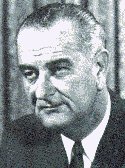
|
Presidents Theme
edHelper.com Subscribers: Click Here to Build a New Printable Version of this Pre-Made Worksheet! |
Return to Presidents Theme |
| Who is this president? |

|
 ____ became the 36th president following the assassination of John F. Kennedy on November 23, 1963. His political career spanned nearly four decades from the 1930s through the 1960s. He was born near Stonewall, Texas, on August 27, 1908, and was the oldest of five children. His father was a member of the Texas House of Representatives and his mother was the daughter of a state legislator. While he was attending Southwest Texas State Teachers College in the late 1920s, he took a teaching position at a predominately Mexican-American school. The extreme poverty of the students made a lasting impression on him. His close ties with the Mexican-American community also helped in the 1960 election. "The Great Society" was a milestone of his presidency while the Vietnam War left a negative mark on his legacy. In 1964 he signed into law the Civil Rights Act, the most comprehensive civil rights legislation since the Reconstruction Era. The act prohibited racial segregation and discrimination in places of public accommodation, guaranteed equal voting rights, and prohibited discrimination by race or sex in employment or union membership. He viewed many of his programs as an extension of the "New Deal" programs of President Franklin Roosevelt. ____, while serving in the House of Representatives, became the first member of Congress to serve on active duty during World War II. He was a Lieutenant Commander in the Navy, and he was awarded the Silver Star for gallantry after his plane was attacked by the Japanese over New Guinea. In the national election of 1959, he lost the nomination for president to John F. Kennedy and in a surprise move, agreed to serve as Kennedy's vice president on the Democratic ticket. His discomfort at being the vice president was well known. Despite being appointed chairman of several important committees, he felt ignored by President Kennedy who failed to use ____'s legendary knowledge of Congress. His Texas drawl and sense of humor contrasted greatly to the Kennedy "sophisticated charm" and influences of the Eastern establishment in which the Kennedy's were well entrenched. Following Kennedy's death, ____ pushed for Congressional passage of Kennedy's legislative agenda. Escalation of the Vietnam conflict, started during the Eisenhower administration, wore heavily on ____ and the nation. As America's involvement deepened during his second term as president, national unrest rose on two fronts: civil rights and Vietnam. On these issues the country became divided and violence spread across the country. As election time drew near in 1969, he announced that he would not be a candidate for re-election as president of the United States. He died of a heart attack suffered at his LBJ Ranch on January 22, 1973.
____ became the 36th president following the assassination of John F. Kennedy on November 23, 1963. His political career spanned nearly four decades from the 1930s through the 1960s. He was born near Stonewall, Texas, on August 27, 1908, and was the oldest of five children. His father was a member of the Texas House of Representatives and his mother was the daughter of a state legislator. While he was attending Southwest Texas State Teachers College in the late 1920s, he took a teaching position at a predominately Mexican-American school. The extreme poverty of the students made a lasting impression on him. His close ties with the Mexican-American community also helped in the 1960 election. "The Great Society" was a milestone of his presidency while the Vietnam War left a negative mark on his legacy. In 1964 he signed into law the Civil Rights Act, the most comprehensive civil rights legislation since the Reconstruction Era. The act prohibited racial segregation and discrimination in places of public accommodation, guaranteed equal voting rights, and prohibited discrimination by race or sex in employment or union membership. He viewed many of his programs as an extension of the "New Deal" programs of President Franklin Roosevelt. ____, while serving in the House of Representatives, became the first member of Congress to serve on active duty during World War II. He was a Lieutenant Commander in the Navy, and he was awarded the Silver Star for gallantry after his plane was attacked by the Japanese over New Guinea. In the national election of 1959, he lost the nomination for president to John F. Kennedy and in a surprise move, agreed to serve as Kennedy's vice president on the Democratic ticket. His discomfort at being the vice president was well known. Despite being appointed chairman of several important committees, he felt ignored by President Kennedy who failed to use ____'s legendary knowledge of Congress. His Texas drawl and sense of humor contrasted greatly to the Kennedy "sophisticated charm" and influences of the Eastern establishment in which the Kennedy's were well entrenched. Following Kennedy's death, ____ pushed for Congressional passage of Kennedy's legislative agenda. Escalation of the Vietnam conflict, started during the Eisenhower administration, wore heavily on ____ and the nation. As America's involvement deepened during his second term as president, national unrest rose on two fronts: civil rights and Vietnam. On these issues the country became divided and violence spread across the country. As election time drew near in 1969, he announced that he would not be a candidate for re-election as president of the United States. He died of a heart attack suffered at his LBJ Ranch on January 22, 1973.
|
Answer Key
|